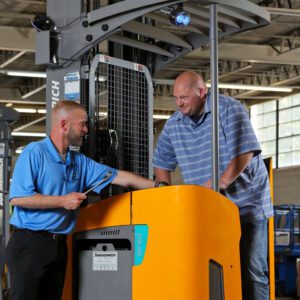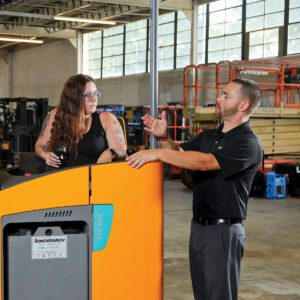
3 Ways To Increase Warehouse Efficiency
Efficient warehouses lead to happy customers – it’s that simple. Read on to discover the top 3 tips to improve your warehouse’s overall efficiency and
Ensuring effective operator training and safety in a warehouse environment is essential for maintaining productivity and minimizing accidents. Here are some solutions to enhance operator training and promote a culture of safety:
1. Develop Comprehensive Training Programs
Develop comprehensive and structured training programs that address all aspects of equipment operation, safety protocols, and emergency procedures. These programs should be tailored to the specific features, functions, and operational requirements of various types of equipment, such as forklifts, pallet jacks, and automated systems. This ensures operators gain a thorough understanding of the machines they will use.
To accommodate different levels of experience, courses should be designed for beginners, intermediate operators, and those in need of refresher training. Beginners can focus on foundational skills, including equipment basics and safe handling techniques, while intermediate operators can advance their knowledge with efficiency strategies and troubleshooting skills. Refresher training keeps experienced operators updated on the latest protocols and safety practices.
Safety should be a central focus, with detailed instruction on workplace safety rules, load management, facility traffic patterns, and ergonomics to reduce the risk of accidents and injuries. Realistic simulations and scenarios can help reinforce these lessons. Emergency response preparedness is also critical, covering procedures for equipment malfunctions, hazardous spills, and fire incidents. Practical drills and role-playing exercises are effective ways to build confidence and readiness.
Incorporating various teaching methods, such as classroom instruction, hands-on demonstrations, virtual simulations, and e-learning modules, ensures that the training is engaging and accessible to all learning styles. Regular assessments and certification processes validate operators’ understanding and readiness, while ongoing development opportunities encourage continuous improvement and address evolving workplace challenges.
By adopting these approaches, companies can develop a skilled workforce that operates safely and efficiently, supporting both productivity and compliance with industry standards.
 2. Utilize Hands-On Training
2. Utilize Hands-On Training
Offer hands-on training opportunities that enable operators to practice using equipment in a controlled and supervised environment. These practical sessions are essential for bridging the gap between theoretical knowledge and real-world application, allowing operators to build the skills and confidence necessary for safe and efficient machinery operation.
Controlled environments provide a safe space for operators to familiarize themselves with the equipment’s controls, functions, and capabilities without the pressure or risks associated with live work settings. Trainers can simulate a variety of scenarios that operators are likely to encounter on the job, such as navigating tight spaces, managing heavy or irregular loads, and responding to unexpected challenges.
Through direct interaction with the equipment, operators develop a deeper understanding of critical safety practices, such as maintaining visibility, adhering to weight limits, and executing proper start-up and shutdown procedures. Practical training also helps operators recognize and mitigate potential hazards, enhancing their ability to make informed decisions in dynamic work environments.
Hands-on sessions should be structured to accommodate different experience levels. Beginners can focus on mastering basic operations, while more experienced operators can refine advanced techniques and troubleshoot common issues. The presence of experienced trainers ensures immediate feedback and correction, fostering a supportive learning atmosphere.
Incorporating realistic training exercises, such as maneuvering through mock warehouse setups or performing simulated emergency responses, further strengthens operators’ readiness. This approach not only reinforces theoretical knowledge but also equips operators with the practical expertise needed to perform their duties safely, efficiently, and confidently.
3. Hold Regular Safety Refreshers
Implement a schedule of regular safety refresher courses to ensure that all operators remain vigilant and up-to-date on the latest safety protocols. These sessions serve as a vital tool to reinforce existing knowledge, address emerging risks, and maintain a culture of safety throughout the organization.
Refresher courses help keep safety practices top-of-mind, emphasizing their importance in day-to-day operations. Operators are reminded of critical procedures, such as proper equipment handling, load balancing, and adherence to facility traffic rules, reducing the risk of complacency or unsafe habits developing over time.
As new safety regulations, technologies, or equipment updates are introduced, these sessions provide a platform to educate staff on necessary adjustments. They also offer an opportunity to review and analyze past incidents or near misses, promoting continuous learning and improvement.
Frequent training is particularly valuable in addressing personnel changes, such as onboarding new hires or accommodating role transitions. Refresher courses ensure that all employees, regardless of their tenure, maintain a consistent understanding of safety expectations and protocols.
To maximize engagement and effectiveness, courses can incorporate interactive elements, such as hands-on drills, quizzes, and group discussions. Practical scenarios and real-world examples can further reinforce key concepts and encourage proactive problem-solving.
By prioritizing regular safety refresher courses, organizations can foster a workforce that consistently values safety, enhances operational efficiency, and minimizes risks, creating a safer work environment for everyone.
 4. Establish Safety Protocols and Guidelines
4. Establish Safety Protocols and Guidelines
Establish and clearly define comprehensive safety protocols and guidelines for operating equipment and performing tasks within the warehouse. These protocols should address every aspect of safe operation, from basic equipment handling to navigating the workspace and managing specific hazards unique to the facility. A well-defined set of guidelines helps create a consistent standard for safety that all employees can understand and adhere to.
To ensure accessibility, make the safety guidelines readily available in multiple formats, such as printed manuals, digital resources, and strategically placed signage throughout the warehouse. Visual aids, like charts, diagrams, and infographics, can effectively communicate key points and serve as quick reminders in high-traffic areas.
Regular communication and reinforcement of these guidelines are essential. Conduct safety briefings, team meetings, and training sessions to review protocols and address any updates or changes. Engage employees in discussions about these rules to encourage questions and clarify any uncertainties. This inclusive approach promotes better understanding and compliance.
It’s critical to adapt guidelines to the specific roles and tasks within the warehouse. For instance, forklift operators should have clear instructions on pre-use inspections, load limits, and maneuvering in tight spaces, while pickers and packers might need guidelines for ergonomic practices and working safely around equipment.
To ensure adherence, integrate safety protocols into daily workflows and reinforce accountability. Supervisors should monitor compliance and provide immediate feedback when protocols are not followed. Recognizing and rewarding consistent adherence to safety practices can further motivate operators to prioritize these guidelines.
By clearly defining, communicating, and enforcing safety protocols, organizations can cultivate a workplace culture that prioritizes the well-being of all employees, reduces the risk of accidents, and enhances overall operational efficiency.
5. Encourage Reporting of Near-Misses
Foster an open and supportive workplace culture where employees feel empowered and encouraged to report near-misses, unsafe conditions, or potential hazards without fear of criticism, retribution, or negative consequences. By creating this environment, organizations can tap into valuable insights from the frontline workforce, identifying risks and implementing proactive measures to enhance overall safety.
Promote this culture by openly communicating the importance of reporting safety concerns during onboarding, training sessions, and team meetings. Emphasize that reporting is not about assigning blame but about fostering a collective responsibility for maintaining a safe work environment. Managers and supervisors should lead by example, demonstrating a positive and constructive attitude toward safety feedback.
Establish simple and accessible reporting mechanisms to make the process easy for employees. This could include anonymous reporting forms, dedicated email addresses, or mobile apps for logging near-misses and unsafe conditions. Having multiple options ensures that all employees, regardless of their comfort level or tech skills, can participate.
Once reports are submitted, treat them with urgency and respect. Investigate each case thoroughly, analyzing contributing factors and identifying patterns that may indicate systemic issues. Use this information to prioritize areas for improvement, such as revising protocols, enhancing training programs, or addressing equipment malfunctions.
Transparency is key to building trust in the reporting process. Share the outcomes of investigations and the corrective actions taken to address concerns, demonstrating that employee feedback leads to tangible improvements. Recognizing employees who actively contribute to safety initiatives, whether publicly or privately, further reinforces a culture of accountability and collaboration.
By cultivating an environment where employees feel safe and motivated to report near-misses and hazards, organizations can continuously improve safety practices, mitigate risks, and prevent future incidents, ultimately creating a safer and more productive workplace for everyone.
6. Use Visual Aids and Signage
Ensure the warehouse is equipped with clear, visible safety signs and instructions strategically placed in high-traffic and high-risk areas. These visual aids play a critical role in reinforcing safety protocols and operational procedures, serving as constant, easy-to-understand reminders for employees.
Safety signage should be designed to be attention-grabbing and straightforward, using bold colors, clear fonts, and universally recognized symbols to ensure quick comprehension. For example, areas requiring personal protective equipment (PPE) should have signs prominently displaying the required gear, such as hard hats, safety goggles, or gloves. Similarly, equipment zones can feature warnings, such as “Caution: Forklift Operating Area” or “Keep Clear of Moving Machinery.”
Operational instructions can be displayed near specific equipment, outlining step-by-step procedures for safe use. For instance, forklifts, pallet jacks, and conveyor systems should have signage detailing inspection checklists, load capacity limits, and emergency shutdown protocols. These reminders help operators adhere to safe practices even during busy or high-pressure shifts.
In addition to static signs, consider incorporating dynamic visual aids, such as digital displays or LED boards, to provide real-time updates, reminders, or alerts about changing conditions, such as maintenance work or weather-related hazards.
Ensure that signs are multilingual or use universal icons to accommodate a diverse workforce and overcome language barriers. Regularly inspect signage to confirm it remains visible, legible, and relevant. Replace any faded, damaged, or outdated signs promptly to maintain their effectiveness.
Integrating safety signage with employee training reinforces the concepts covered during instruction, embedding them into the daily workflow. Together, these visual cues and training create a layered approach to safety, helping to minimize risks, reduce incidents, and promote a culture of awareness and vigilance across the warehouse.
7. Promote a Safety Culture
Cultivate a strong culture of safety by actively involving all employees in safety initiatives and creating a shared sense of responsibility for maintaining a safe work environment. When employees feel personally invested in their safety and that of their colleagues, they are more likely to follow protocols, identify hazards, and promote best practices.
Engage employees by encouraging their participation in safety committees, hazard assessments, and policy development. Allowing them to contribute their perspectives ensures that safety measures are practical and tailored to the realities of daily operations. This inclusive approach fosters a sense of ownership and accountability across all levels of the organization.
Provide regular opportunities for employees to share feedback on safety practices, whether through surveys, meetings, or informal conversations. Actively listening to their insights and acting on them demonstrates that their input is valued, reinforcing their commitment to maintaining a safe environment.
Create opportunities for peer-to-peer collaboration on safety, such as buddy systems or mentorship programs where experienced workers can guide newer employees. This not only strengthens safety awareness but also builds teamwork and trust.
Recognizing and rewarding safe practices is essential for sustaining a culture of safety. Acknowledge individuals or teams who consistently follow protocols, report hazards, or go above and beyond to prevent incidents. Rewards can range from verbal recognition during meetings to tangible incentives, such as bonuses, certificates, or small tokens of appreciation. Publicly celebrating these efforts underscores the importance of safety and motivates others to follow suit.
Reinforce the message that safety is a shared responsibility through ongoing communication, training, and visible leadership commitment. When managers and supervisors model safe behavior, it sets a powerful example for the rest of the team.
By involving employees in safety initiatives, promoting accountability, and celebrating successes, organizations can embed safety into their workplace culture. This approach not only reduces risks and improves compliance but also enhances employee morale and productivity, contributing to a healthier, more efficient work environment.
Tri-Lift NJ has your training needs covered! We offer safety training for operators that has been developed in accordance with Federal OSHA Standards. Contact us today to learn more about how we can help ensure your operation is safe and productive!

Efficient warehouses lead to happy customers – it’s that simple. Read on to discover the top 3 tips to improve your warehouse’s overall efficiency and

Improving equipment utilization and productivity in a warehouse setting is essential for optimizing operations and minimizing costs. Here are several effective solutions to enhance both:
732.220.0444
1471 Jersey Avenue
North Brunswick, NJ 08902